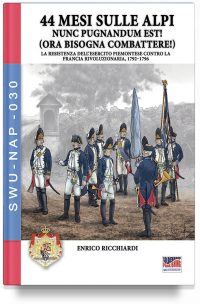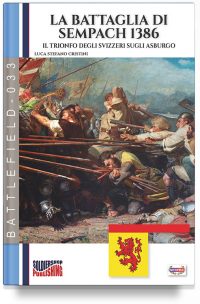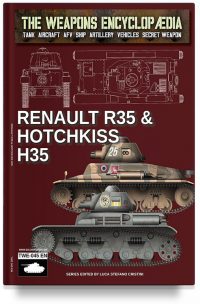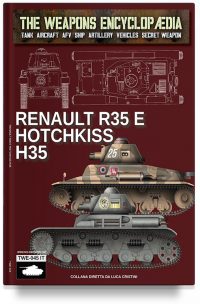-

Alba, città contesa 1944-1945
- €19,90
- La città di Alba fece da sfondo agli scontri tra partigiani e truppe dell’Asse tra il 1944 e 1945 e venne addirittura occupata dalle forze della Resistenza nell’ottobre 1944, che però ne mantennero il controllo solo per pochi giorni, i famosi “23 giorni di Alba”, descritti proprio da Beppe Fenoglio nell’omonimo libro. La città venne nuovamente attaccata dai partigiani il 15 aprile 1945, in uno scontro che durò per tutto il giorno, ma che non sloggiò il presidio repubblichino dalla…
-

Alba, a disputed city 1944-1945
- €19,90
- The town of Alba was the backdrop to the clashes between partisans and Axis troops between 1944 and 1945 and was even occupied by Resistance forces in October 1944, who, however, only maintained control for a few days, the famous '23 days of Alba', described by Beppe Fenoglio in his book of the same name. The town was again attacked by partisans on 15 April 1945, in a clash that lasted all day, but did not dislodge the republican garrison…
-

Volontari spagnoli in Germania durante la Seconda Guerra Mondiale – Vol. 2
- €19,90
- Durante la Seconda guerra mondiale, la Spagna non partecipò come nazione, anche se molti spagnoli vi presero parte, sia da una parte che dall’altra. Dopo la guerra civile spagnola, il regime di Francisco Franco era moralmente e materialmente in debito con la Germania e con l’Italia, e questo portò ad allineare la Spagna all’Asse. L’invasione dell’Unione Sovietica da parte delle truppe dell’Asse diede al governo spagnolo l’opportunità di soddisfare la richiesta di molti ex combattenti e di giovani che non…
-

Spanish volunteers in Germany during World War II – Vol. 2
- €19,90
- During World War II, Spain did not participate as a nation, although many Spaniards took part, both on one side and the other. After the Spanish Civil War, Francisco Franco’s regime was morally and materially indebted to Germany and Italy, which led to Spain’s alignment with the Axis. The invasion of the Soviet Union by Axis troops gave the Spanish government the opportunity to meet the demand of many ex-combatants and young people who had not had the opportunity to…
-

Volontari spagnoli in Germania durante la Seconda Guerra Mondiale – Vol. 1
- €19,90
- Durante la Seconda guerra mondiale, la Spagna non partecipò come nazione, anche se molti spagnoli vi presero parte, sia da una parte che dall’altra. Dopo la guerra civile spagnola, il regime di Francisco Franco era moralmente e materialmente in debito con la Germania e con l’Italia, e questo portò ad allineare la Spagna all’Asse. L’invasione dell’Unione Sovietica da parte delle truppe dell’Asse diede al governo spagnolo l’opportunità di soddisfare la richiesta di molti ex combattenti e di giovani che non…
-

Spanish volunteers in Germany during World War II – Vol. 1
- €19,90
- During World War II, Spain did not participate as a nation, although many Spaniards took part, both on one side and the other. After the Spanish Civil War, Francisco Franco’s regime was morally and materially indebted to Germany and Italy, which led to Spain’s alignment with the Axis. The invasion of the Soviet Union by Axis troops gave the Spanish government the opportunity to meet the demand of many ex-combatants and young people who had not had the opportunity to…
-
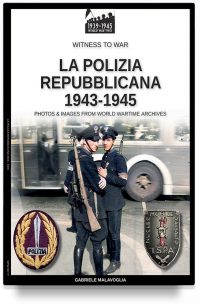
La Polizia Repubblicana 1943-1945
- €19,90
- Anche la Repubblica Sociale ebbe la propria struttura di Pubblica Sicurezza, il corpo della Polizia Repubblicana, formata da una sorta di doppia anima: una territoriale, impegnata nei compiti d’istituto della Polizia, e una più spiccatamente figlia del tremendo periodo che si stava vivendo, dedita principalmente alla persecuzione degli avversari politici del fascismo, i partigiani, ed alla caccia agli ebrei. A volte queste due anime si compenetrarono, nonostante la suddivisione rimase molto netta. Fino ad oggi, ben poco è stato scritto…
-
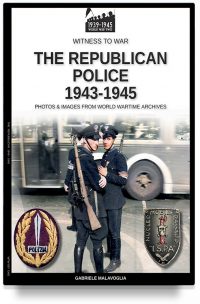
The Republican Police 1943-1945
- €19,90
- The Social Republic had its own Public Security structure, the Republican Police Corps, formed by a kind of dual soul: one territorial, engaged in the institutional tasks of the Police, and one more distinctly a child of the tremendous period that was being experienced, devoted mainly to the persecution of the political opponents of fascism, the partisans, and the hunting of jews. At times these two souls interpenetrated, although the division remained very sharp. Until now very little has been…
-

Occupazione italiana dell’Albania – L’Anschluss italiano
- €19,90
- L’occupazione italiana dell’Albania, avvenuta nell’Aprile 1939, è un tema poco trattato dalla maggior parte dei testi inerenti alla storia delle nostre forze armate e spesso viene citato in poche righe o descritto come un’azione di poca importanza e senza difficoltà. Nella realtà, l’invasione del Regno d’Albania fu un campanello d’allarme e mostrò tutta l’inefficienza delle regie forze armate italiane in una guerra moderna come sarà poi la Seconda Guerra Mondiale che vedrà il Regno d’Italia subire una sconfitta dopo l’altra.…
-

Albania’s Italian occupation – The Italian Anschluss
- €19,90
- The Italian occupation of Albania, which took place in April 1939, is a subject little covered in most texts pertaining to the history of our armed forces and is often mentioned in a few lines or described as an action of little importance and without difficulty. In reality, the invasion of the Kingdom of Albania was a wake-up call and showed all the inefficiency of the Italian Royal Armed Forces in a modern war as the Second World War would…
-
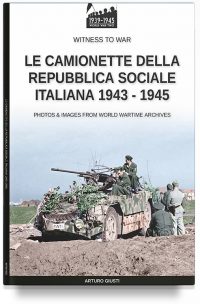
Le camionette della Repubblica Sociale Italiana 1943-1945
- €19,90
- Le camionette furono un perfetto esempio di capacità di adattamento delle forze del Regio Esercito nella Seconda Guerra Mondiale, sia i modelli sviluppati in patria che le versioni improvvisate. Vennero ovviamente recuperate e ripiegate dalle forze della Repubblica Sociale Italiana dopo l’Armistizio dell'8 Settembre 1943 con compiti completamente nuovi. Dalla perlustrazione delle vaste aree desertiche nordafricane, le camionette vennero impiegate e trasformate per la lotta antipartigiana che performarono con non pochi limiti. In questo libro analizzeremo il servizio delle camionette con i…
-
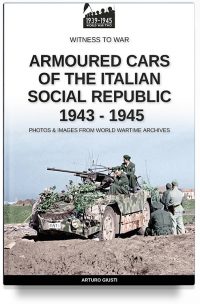
Armoured cars of the Italian Social Republic 1943-1945
- €19,90
- The armoured cars were a perfect example of the adaptability of the Royal Army's forces in World War II, both the domestically developed models and the improvised versions. They were obviously recovered and redeployed by the forces of the Italian Social Republic after the Armistice of 8 September 1943 with completely new tasks. From the patrols of the vast North African desert areas, the small trucks were employed and transformed for anti-partisan combat, which they performed with not a few…
-
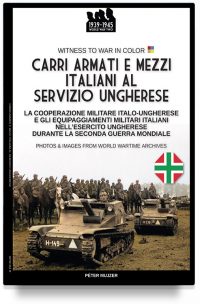
Carri armati e mezzi italiani al servizio ungherese
- €32,00
- Novità: WTW A COLORI! Alla fine della Prima Guerra Mondiale, l’Ungheria, in quanto membro della monarchia austroungarica, si ritrovò dalla parte dei perdenti. Il suo esercito si disintegrò e i suoi armamenti furono acquisiti o distrutti dalle nazioni alleate vincitrici. Tuttavia alla fine degli anni Venti la diplomazia ungherese fece di tutto per ridurre il suo isolamento, stringendo rapporti con l’Italia e altri paesi vicini per cercare di creare una posizione migliore per l’Ungheria tra le nazioni europee. Ebbe subito…
-
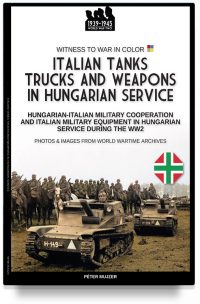
Italian tanks trucks and weapons in Hungarian service
- €32,00
- NEW: WTW IN COLOR! At the end of the First World War, Hungary, as a member of the Austro-Hungarian monarchy, found itself on the losing side. Its army disintegrated and its armaments were acquired or destroyed by the victorious Allied nations. However, in the late 1920s, Hungarian diplomacy did all it could to reduce its isolation, forging relations with Italy and other neighboring countries to try to create a better position for Hungary among European nations. A kind of secret…
-
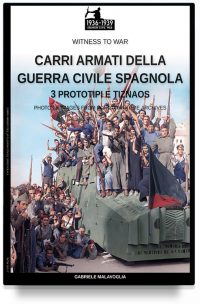
Carri armati della guerra civile spagnola – Vol. 3
- €19,90
- La Guerra Civile Spagnola fu il primo conflitto a vedere veri scontri tra carri armati, impiegati da entrambi le parti in causa (nello stesso periodo l’Italia stava combattendo in Etiopia, impiegando un buon numero di mezzi corazzati, ma contro un nemico del tutto privo di carri armati). La Spagna fu così il campo di prova per la guerra moderna tra mezzi corazzati inviati dall’Italia, dalla Germania e dalla Russia. L’utilizzo di carri armati durante la Guerra Civile lasciò intravedere soltanto…
-
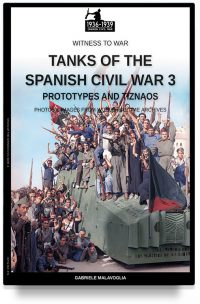
Tanks of the Spanish Civil War – Vol. 3
- €19,90
- The Spanish Civil War was the first conflict to see real clashes between tanks, employed by both sides (at the same time, Italy was fighting in Ethiopia, employing a good number of armoured vehicles, but against an enemy with no tanks at all). Spain was thus the testing ground for modern warfare between armoured vehicles sent from Italy, Germany and Russia. The use of tanks during the Civil War only hinted at some of those aspects that would later make…
-
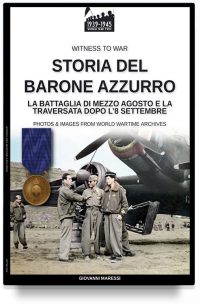
Storia del Barone Azzurro
- €19,90
- Questa è la Storia del Barone Azzurro, al secolo Carlo Luigi Amedeo Winspeare Guicciardi e della sua attiva partecipazione alla seconda guerra mondiale come ufficiale pilota nella Regia Aeronautica. Ma facciamo due passi indietro. Carlo Winspeare figlio di Edoardo e di Clara Sarauw nacque il 13 marzo 1917 a La Valletta (Malta) dove il padre, che aveva girato il mondo al seguito di Luigi Amedeo di Savoia, l’avventuroso Duca degli Abruzzi, svolgeva la funzione di attaché militaire, quale ufficiale della…
-
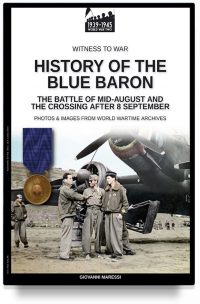
History of the Blue Baron
- €19,90
- This is the story of the Blue Baron, born Carlo Luigi Amedeo Winspeare Guicciardi and his active participation in the Second World War as a pilot officer in the Regia Aeronautica. But let us take two steps back. Carlo Winspeare, son of Edoardo and Clara Sarauw, was born on 13 March 1917 in Valletta (Malta) where his father, who had travelled the world in the retinue of Luigi Amedeo di Savoia, the adventurous Duke of the Abruzzi, was working as…
-
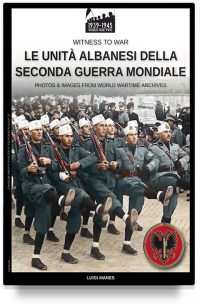
Le unità albanesi della Seconda Guerra Mondiale
- €19,90
- Il 16 aprile 1939, presso il Quirinale, Vittorio Emanuele III ricevette la Corona d’Albania. Le sorti del “Paese delle Aquile” furono così unite a quelle d’Italia. Alle trasformazioni istituzionali si accompagnò l’incorporazione delle forze armate albanesi in quelle italiane. L’Albania riuscì a ricreare un autonomo ma piccolo esercito solo dopo l’Armistizio dell’8 settembre 1943. A partire da tale data i tedeschi, massimamente interessati al controllo del territorio e alla salvaguardia della neutralità dello Stato balcanico, si avvalsero del supporto di…
-
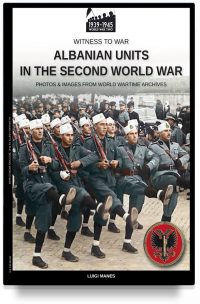
Albanian units in the Second World War
- €19,90
- On 16 April 1939 Victor Emmanuel III received the Crown of Albania at the Quirinal Palace. The “Land of the Eagles” and Fascist Italy would thus share a common destiny. Institutional changes were accompanied by the integration of the Albanian armed forces into the Italian ones. Albania managed to recreate an autonomous yet small army only after the Armistice of 8 September 1943. From that date the Germans, interested in controlling the territory and safeguarding the neutrality of the Balkan…
-
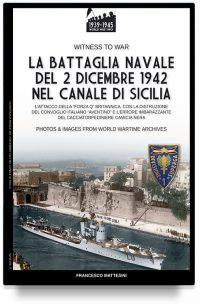
La battaglia navale del 2 dicembre 1942 nel canale di Sicilia
- €19,90
- La battaglia anche detta del banco di Skerki ebbe luogo il 2 Dicembre 1942, nel mar Mediterraneo nei pressi della costa tunisina. Un convoglio mercantile italiano, scortato da alcune navi da guerra della Regia Marina e diretto in Libia per rifornire le truppe dell’Asse in Africa settentrionale, fu attaccato da una squadra navale della Royal Navy. Il convoglio italiano era costituito da un piroscafo tedesco, e da alcune motonavi italiane. La squadra d’attacco britannica nella battaglia affondò l’intero convoglio -…
-
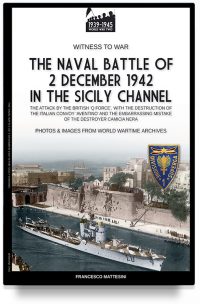
The naval battle of 2 december 1942 in the Siciliy Channel
- €19,90
- The battle also known as the Battle of Skerki Bank took place on December 2, 1942, in the Mediterranean Sea near the Tunisian coast. An Italian merchant convoy, escorted by several Royal Navy warships and bound for Libya to resupply Axis troops in North Africa, was attacked by a Royal Navy naval squadron. The Italian convoy consisted of a German steamer, and several Italian motor ships. The British attack squadron in the battle sank the entire convoy-as well as the…
-
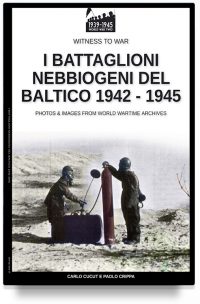
I battaglioni nebbiogeni del Baltico 1942-1945
- €19,90
- La comparsa dell’arma aerea sui campi di battaglia impose agli Stati Maggiori di trovare con la massima urgenza le contromisure per affrontare in modo efficacie la nuova minaccia. Il Regio Esercito istituì il 1° luglio 1923, all’interno dell’Arma del Genio, il Servizio Chimico Militare. E all’interno dello stesso, tra i battaglioni specialistici costituiti e addestrati dal Reggimento Chimico vi erano i battaglioni nebbiogeni. Il compito dei reparti appartenenti ai battaglioni nebbiogeni, era quello di oscurare l’obiettivo alla vista degli equipaggi…
-
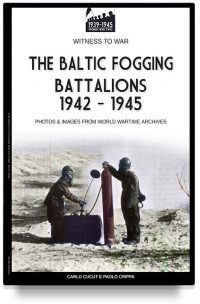
The Baltic fogging battalions 1942-1945
- €19,90
- The appearance of the air weapon on the battlefields required major states to find with the utmost urgency countermeasures to deal effectively with the new threat. The Royal Army established on July 1, 1923, within the Engineer Corps, the Military Chemical Service. And within the same, among the specialized battalions established and trained by the Chemical Regiment were the fog battalions. The task of the units belonging to the fog battalions, was to obscure the target from the view of…
-
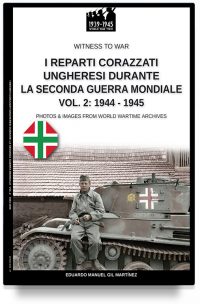
I reparti ungheresi durante la Seconda Guerra Mondiale – Vol. 2: 1944-1945
- €19,90
- Le azioni delle forze corazzate tedesche durante la Seconda guerra mondiale sono ben note. Ciò che non è ancora stato raccontato con altrettanta precisione sono le azioni delle forze corazzate degli alleati della Germania. Se è vero che le loro prestazioni sono state in genere del tutto secondarie rispetto a quelle che hanno potuto permettersi le forze del Reich tedesco, occorre sottolineare le azioni delle forze corazzate ungheresi, che non solo sono riuscite a organizzare in sostanziale autonomia le proprie…

